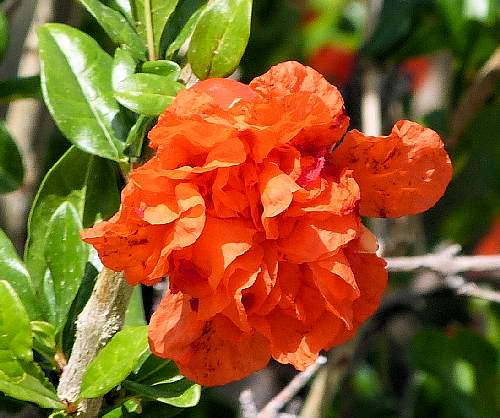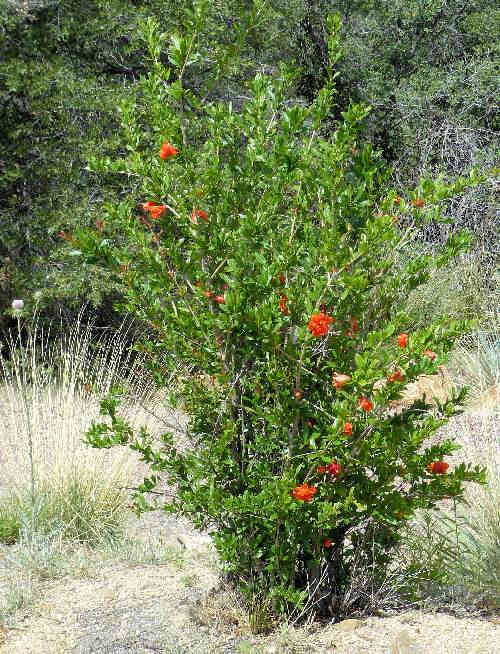Growing Pomegranate:
Punica granatum
Back to Fruit, Berries and Nuts
Botanical Overview
Now placed in the Loosestrife family (Lythraceae), the Punica genus has only two species, the most well known being Punica granatum: Pomegranate. Hundreds of cultivars are grown throughout the world.
Description
Form:
A many-branched shrub sometimes pruned into a small tree.
Lifespan:
Up to 300 years with best fruit production in the first 25-35 years.
Leaf retention:
Deciduous.
Growth rate:
Slow to moderate.
Mature Size:
6-33' (1.8-10m) high, depending on cultivar, but usually 15' (4.5m) high when not pruned.
Flowers:
Bisexual flowers (called female), "male" flowers (with atrophied female parts) and
intermediate flowers form on the same plant, often next to one another.
Male flowers have a short bell shape, usually have no petals, and can make up to 60-70% of the total flowers on a plant, depending on climate, cultivar, and season. The plant seems to use this ratio to conserve energy when conditions for fruiting are marginal. Intermediate flowers are sometimes fertile and usually need cross-pollination from another plant.
Bisexual flowers are showy, trumpet shaped, with ruffled petals, about 2" (5cm) long, often double, usually orange-red, and lacking fragrance. They are produced over a long period, and develop fruit when pollinated. Some ornamental cultivars produce no fruit but have large flowers available in many colors, including white.
Male flowers and any other unpollinated flowers will typically drop off after bloom. Other reasons for flower drop can be cold temperature, drought, insect infestation or root fungal disease.
Male flowers have a short bell shape, usually have no petals, and can make up to 60-70% of the total flowers on a plant, depending on climate, cultivar, and season. The plant seems to use this ratio to conserve energy when conditions for fruiting are marginal. Intermediate flowers are sometimes fertile and usually need cross-pollination from another plant.
Bisexual flowers are showy, trumpet shaped, with ruffled petals, about 2" (5cm) long, often double, usually orange-red, and lacking fragrance. They are produced over a long period, and develop fruit when pollinated. Some ornamental cultivars produce no fruit but have large flowers available in many colors, including white.
Male flowers and any other unpollinated flowers will typically drop off after bloom. Other reasons for flower drop can be cold temperature, drought, insect infestation or root fungal disease.
Bloom:
Winter into spring, or spring through summer, depending on the local climate.
Self-fruitful:
This plant is self-pollinating, but cross-pollination from another cultivar often increases
fruit set.
Years before fruiting:
It can start flowering in its second or third year, but fruit production becomes larger after
5-6 years.
Fruit:
Shiny, reddish, spherical, with a cylindrical cap on the blossom end. Each seed is encased in
a sack (aril) containing juicy pulp. The juice, pulp and seeds are edible. The juice and pulp
are usually red, but in some cultivars are pink or white, possibly non-staining, and sweeter.
Temperature can affect the color of the pulp surrounding the seeds, which will be clear or have a light color in hot weather and become darker red when temperatures turn cold. The darker colored pulp will have more flavor.
Fruit drop can occur when the plant is over fertilized or over watered.
Temperature can affect the color of the pulp surrounding the seeds, which will be clear or have a light color in hot weather and become darker red when temperatures turn cold. The darker colored pulp will have more flavor.
Fruit drop can occur when the plant is over fertilized or over watered.
Months for fruit to ripen:
5-7. Depending on the cultivar, fruit may be early ripening in August-September to late
ripening in October-November. Late harvest fruit are often harvested after the first cold
snap in November. Fruit are often considered ripe when (1) the fruit surface changes from
being round to slightly bumpy or slightly flattened sides – often an indicator of
close to ripe,
(2) the surface loses shininess, or (3) tapping on the fruit produces a metallic sound.
The indicators for ripeness must be learned for each cultivar and location.
If the fruit cracks open, it should be picked immediately. Fruit cracking can occur because of excess rain near maturity or because the fruit is ripe. Harvest the fruit using clippers near the base of the fruit. Pomegranates do not ripen further once harvested. Allowing ripe fruit to remain on the plant risks cracking when rain or continued irrigation occurs.
If the fruit cracks open, it should be picked immediately. Fruit cracking can occur because of excess rain near maturity or because the fruit is ripe. Harvest the fruit using clippers near the base of the fruit. Pomegranates do not ripen further once harvested. Allowing ripe fruit to remain on the plant risks cracking when rain or continued irrigation occurs.
Storage after harvest:
Refrigerated fruit can last up to 7 months.
Leaves:
Shiny, dark green, lance-shaped, about 3" (7.6cm) long. On some cultivars, new leaves appear
red and gradually change to green as they become full size.
Stems:
Branches may have spines. The bark is red-brown.
Roots:
No more than 3' (1m) deep, non-invasive, with a tendency to sucker.
Cultivars of note for hot climates:
'Ariana' large vivid red fruit, small, soft edible
seeds, sweet punchy flavor, rated as one of best tasting, 100 chill hours, Oct-Nov
ripening
'Angel Red' large vivid red fruit, highest juice
content, soft edible seeds, best for juicing, prolific, 150 chill hours, ripens late
summer
'Desertnyi' large orange fruit, dark red arils,
very soft seeds, citrus overtones to flavor, 200 chill hours, Oct-Nov ripening
'Eversweet' large red fruit, virtually seedless,
clear arils, clear, very sweet, non-staining juice, 150 chill hours, ripens late summer
into fall
'Parfianka' large red fruit, very small edible
seeds, sweet red juice, excellent flavor, considered one of the best tasting overall,
100 to 200 chill hours, ripens mid-fall
'Pink Satin' medium-sized, pink to dark red fruit,
medium to large edible seeds, light-colored non-staining juice, sweet fruit-punch flavor,
vigorous, 150-200 chill hours, ripens mid-fall
'Sweet' a sweeter version of 'Wonderful', tiny,
soft, edible seeds, suitable for container growing and espalier, 100 chill hours, ripens
late summer
'Wonderful' medium to large purple-red fruit with
a tangy flavor, medium-hard seeds, vigorous, productive, the standard commercial
pomegranate, 150 chill hours, ripens mid-fall.
Wildlife:
The flowers attract butterflies, bees, and hummingbirds. The leaves may be browsed by deer.
Birds often peck at ripening fruit, which should be covered by individual cloth bags or
bird netting draped over the entire plant.
Toxic / Danger:
All parts of the plant are mildly poisonous except for edible fruit.
Possible spines on branches.
Origin:
Iran to the Himalayas. Usage dates back over 8000 years.
Cultivation and Uses
USDA hardiness zones:
7b-11.
Chill hours:
100-200.
Heat tolerant:
Yes.
Drought tolerant:
Yes.
Sun:
Full sun.
Planting:
Locate this plant in full sun in well draining soil. Be sure there is enough space to walk
around the plant and enough height above to accommodate its mature size.
Pomegranates can be grown in containers.
Soil:
This plant tolerates soil that is well-draining, with pH 5.6-7.8 (acidic to slightly alkaline),
but does best in pH 6.1-7.5 (slightly acidic to neutral).
It is tolerant of soil types and moderately salt tolerant.
Fertilize:
In mid to late winter, before leaf-out, spread an organic fertilizer evenly under the canopy
and at least 8" (21cm) away from the trunk.
Water once established:
Deep water every 3 weeks in warm months when not
fruiting. Do not water when flowering, until fruit set is firmly established and all
non-pollinated flowers have dropped. Watering during flowering may result in premature flower
drop and no fruit set.
During fruiting, to avoid split fruit, water twice a week, a light to moderate amount, compensating for rain. Most split fruit is caused by inconsistent watering. Overwatering can cause the development of molds which may also increase the likelihood of fruit splitting.
To prepare the plant for winter, cut back water substantially after mid October, except for late-ripening fruit. Then reduce watering up to 6 days before the expected harvest to speed ripening.
Insufficient water, and time to water again, is signaled by a few random leaves turning yellow except in the fall when all leaves will turn yellow and drop.
During fruiting, to avoid split fruit, water twice a week, a light to moderate amount, compensating for rain. Most split fruit is caused by inconsistent watering. Overwatering can cause the development of molds which may also increase the likelihood of fruit splitting.
To prepare the plant for winter, cut back water substantially after mid October, except for late-ripening fruit. Then reduce watering up to 6 days before the expected harvest to speed ripening.
Insufficient water, and time to water again, is signaled by a few random leaves turning yellow except in the fall when all leaves will turn yellow and drop.
Mulch:
Spread organic mulch thickly over the root zone to reduce water loss and moderate summer heat.
First Year Care:
Water twice a week, adjusting for rain, and do not over water to avoid root rot.
Use only a light application of an organic, low-nitrogen fertilizer.
Prune:
Remove suckers from roots as they appear. Fruit appears on second year wood.
Prune branches during winter dormancy after the danger of frost has passed.
Most cultivars can be cut on top to any height desired or can be pruned into a single- or
multi-trunk tree, shrub, or hedge.
For a shrub, leave the 3-6 strongest vertical branches and remove the rest.
Litter:
Low to moderate from leaves, flowers, and fruits.
Propagation:
Hardwood cuttings taken in February, dipped in a solution of IBA 500 ppm plus borax 1% for 24
hours, then planted in a misting environment. When grafting, only a few rootstocks take
grafting well. These rootstocks include ‘Gorj-e-Dadashi’, ‘Gorj-e-Shahvar’ and ‘Post
Ghermaz-e-Aliaghai’. Seed are variable and do not grow true to parent.
Pests:
Leaf footed bugs can penetrate the rind to suck out juice, causing an internal fungus
infection in part of the fruit. It is best to harvest damaged fruit as it appears, remove
the infected parts, and consume the rest.
The eggs of leaf-footed bugs can be spotted on the underside of leaves and removed.
The bugs can also be contained by attracting sparrows to feed on them.
Uses:
Ornamental, fruit.
Comments
The bottom two pictures show a non-fruiting, ornamental flower and its shrub.
Do you have additional information or a different experience for these plants that you would like to share? Email info@GardenOracle.com. All contributions are welcome and appreciated.
Do you have additional information or a different experience for these plants that you would like to share? Email info@GardenOracle.com. All contributions are welcome and appreciated.




Latest update: November, 2024
© 2008-2025 by GardenOracle.com

